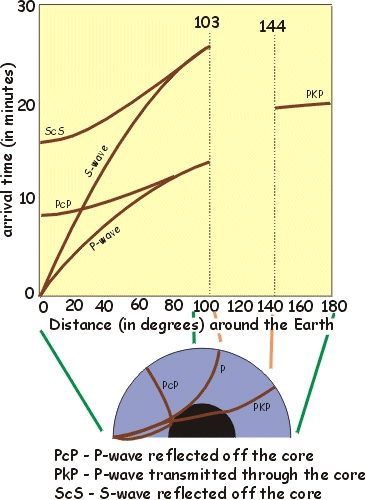

The typical behaviour of seismic waves with distance, using records such as are seen in the linked image can be collated on the adjacent diagram. P-waves and S-waves seem to stop at 103 degrees around the Earth from the earthquake source.
Consider the record of arrivals from a station 40 degrees around the earth from the source. The first arrival is the P-wave (some 6 minutes after the quake). The next arrival is the P-wave reflected off the core-mantle boundary (denoted PcP, some 9 minutes after the quake). Then in comes the first S-wave arrival (at 13 minutes) and then the S-wave reflected off the core-mantle boundary (ScS, at 17 minutes).
Note that for stations approaching the start of the shadow zone start at 103 degrees around the Earth from the earthquake source the arrival times of P and PcP together with S and ScS.
Direct S-waves never reach stations beyond 103 degrees around from the earthquake source. P-waves do reappear after 144 degrees but have been delayed along the way (compared to their expected arrival time if we project the travel-time line from 103 degrees. This delay implies that the deep earth (core) transmits P-waves more slowly than the mantle (n.b. this is primarily because P-waves are transmitted more slowly - but are still transmitted - through liquids than solids).
A more complete picture is shown on the raypath diagram
.